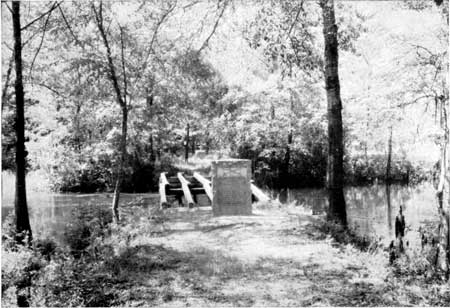MENU
|
Glimpses of Historical Areas East of the Mississippi River |
|
The Revolution |
|
NORTH CAROLINA |
Special Feature: Scene of a memorable battle between North Carolina Whigs and Tories in 1776.

Site of Battle at Moores Creek.
(Photo by Rinehart)
MOORES CREEK NATIONAL MILITARY PARK is situated in southeastern North Carolina on a small creek by that name which flows into the Cape Fear River about 6 miles north of Wilmington. On the banks of this stream North Carolina Patriots and Loyalists engaged in a brief but severe battle on February 27, 1776. The result was a complete victory for the Patriots, securing North Carolina for several years to the Revolutionary cause. This battle is memorable also because of the romantic character of the Scotch volunteers participating on the Tory side. They were Highlanders of the same stock which had served under Bonnie Prince Charlie at Culloden Moor and were led by a MacDonald who had not only fought there but with the British at Bunker Hill.
After the final defeat of the Jacobites at Culloden Moor and the consequent persecution of the Scotch clansmen, thousands of Highlanders emigrated to America and settled in the Cape Fear district of North Carolina. At the outbreak of the Revolutionary War they and their descendants were, on the whole, loyal to the British cause and thousands rallied to the King's standard. Among those who took the lead in arousing them to active resistance were Donald MacDonald; the celebrated Flora MacDonald, who had aided the Stuart Pretender in his escape from Scotland after the debacle at Culloden; her husband, Allan MacDonald; and her son-in-law, Alexander McLeod.
Under the leadership of Donald MacDonald, who had received a commission as brigadier general in the British Army, and McLeod, who had been given a commission as colonel, about 1,600 Highlanders marched from Fayetteville toward Wilmington. The Patriots had kept close watch on the enemy's movements and on February 26, 1776, the Tories found on the opposite side of Moores Creek 1,100 militia and minutemen, partly entrenched, under Col. Richard Caswell. General MacDonald lay ill at a farmhouse, and McLeod, who took command, led the Tory troops to the attack early the next morning. They attempted to cross the creek on the girders of a bridge from which the Patriots had removed the planks. As the head of the Tory column approached the American position, they were met by a murderous fire. Men fell to the ground and into the stream, including the brave McLeod, who was pierced by 20 balls. This volley having driven back the Tory vanguard, a detachment of Americans was thrown over the creek by Caswell, and the disordered Tories soon broke ranks and fled. MacDonald and about 900 of his troops were captured, as well as a large amount of money, arms, and supplies.
Thus the North Carolina Tories were decisively defeated with one sharp blow, and the colony remained in the possession of the Patriots until the British invasion of 1780. The Whigs in the Carolinas, where there was a greater proportion of Tories than in most of the other States, were greatly encouraged by their overwhelming victory. The battle, moreover, helped influence southern delegates to the Continental Congress to sign the Declaration of Independence.
NEXT> Kings Mountain National Military Park
 Top
Top
Last Modified: Thurs, Nov 23 2000 10:00:00 pm PDT
http://www.cr.nps.gov/history/online_books/glimpses3/glimpses2c.htm
![]()
